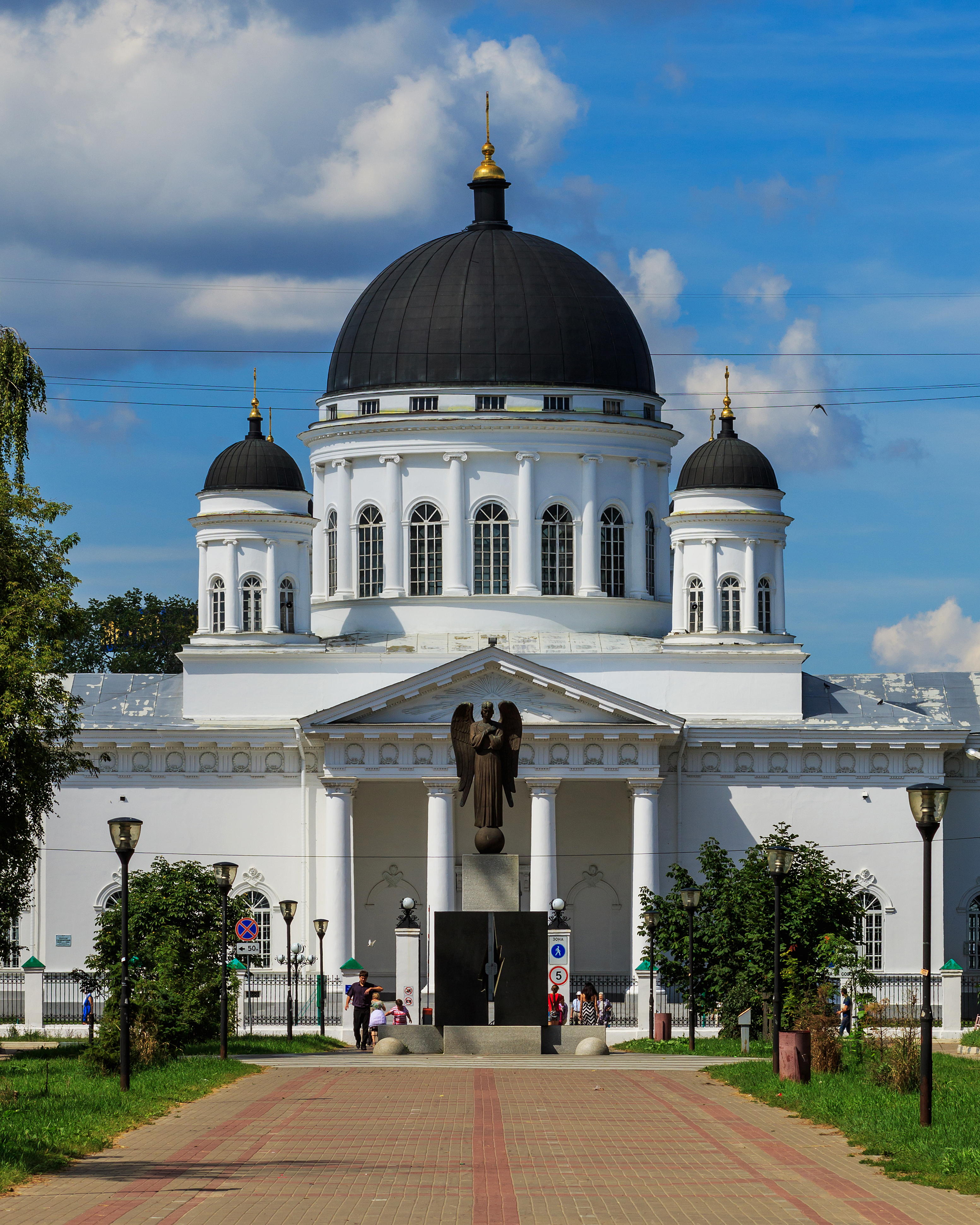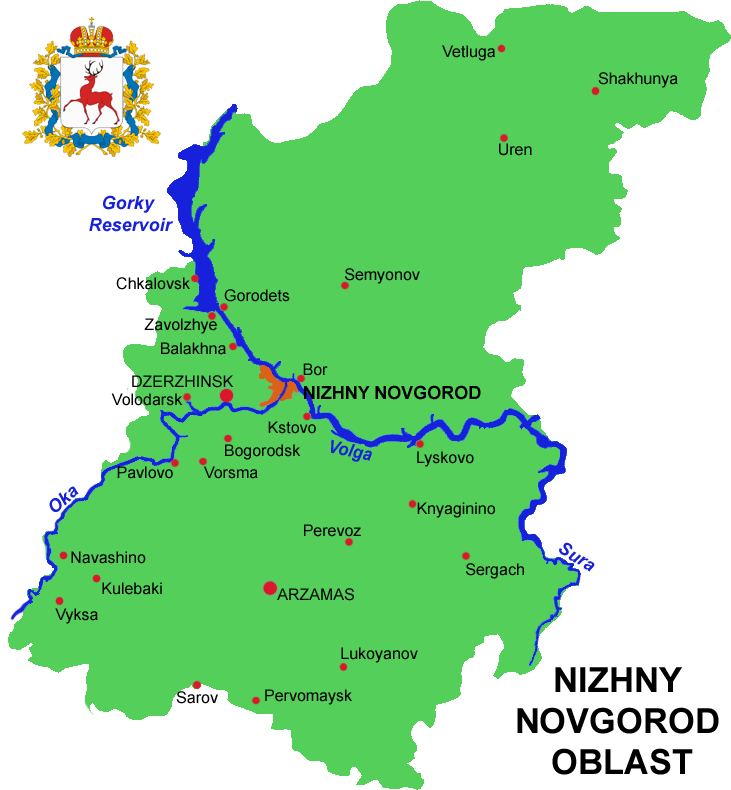|
Lyskovsky District
Lyskovsky District (russian: Лы́сковский райо́н) is an administrative district (raion), one of the forty in Nizhny Novgorod Oblast, Russia.Order #3-od Municipally, it is incorporated as Lyskovsky Municipal District.Resolution #670 It is located in the east of the oblast on both sides of the Volga River. The area of the district is . Its administrative center is the town of Lyskovo. Population: 39,964 ( 2010 Census); The population of Lyskovo accounts for 54.7% of the district's total population. History In the Russian Empire, the territory of what today is Lyskovsky District was mostly within Makaryevsky Uyezd of Nizhny Novgorod Governorate. The seat of the uyezd was in the town of Makaryev (today's settlement of Makaryevo) on the northern bank of the Volga River, next to the ancient Makaryev Monastery. Until the fire of 1816, Makaryev was home to the annual Makaryev Fair. The administrative offices of the uyezd, however, were located in the village of Lyskov ... [...More Info...] [...Related Items...] OR: [Wikipedia] [Google] [Baidu] |
Lyskovo, Nizhny Novgorod Oblast
Lyskovo (russian: Лы́сково) is a town and the administrative center of Lyskovsky District in Nizhny Novgorod Oblast, Russia, located on the southern side of the Volga River (since the 1980s, forming the Cheboksary Reservoir), opposite the mouth of the Kerzhenets River, southeast of Nizhny Novgorod, the administrative center of the oblast. Population: History It was first mentioned in 1410. In 1686, Lyskovo was granted by the Russian government to the émigré Georgian monarch Archil of Imereti. Upon the extinction of his family, the village passed to Princes Gruzinsky, a related line of Georgian royalty who arrived to Russia in 1724. That family owned the village until the death of Prince Georgy Gruzinsky in 1852. From 1749 to 1808, the Lyskovo estate housed St. Nino's Cross, the principal relic of Georgian Christianity. Town status was granted to Lyskovo in 1925. Administrative and municipal status Within the framework of administrative division ... [...More Info...] [...Related Items...] OR: [Wikipedia] [Google] [Baidu] |
Russian Census (2010)
The Russian Census of 2010 (russian: Всеросси́йская пе́репись населе́ния 2010 го́да) was the second census of the Russian Federation population after the dissolution of the Soviet Union. Preparations for the census began in 2007 and it took place between October 14 and October 25. The census The census was originally scheduled for October 2010, before being rescheduled for late 2013, citing financial reasons,Всероссийская перепись населения переносится на 2013 год although it was also speculated that political motives were influential in the decision. However, in late 2009, |
Kazan
Kazan ( ; rus, Казань, p=kɐˈzanʲ; tt-Cyrl, Казан, ''Qazan'', IPA: ɑzan is the capital and largest city of the Republic of Tatarstan in Russia. The city lies at the confluence of the Volga and the Kazanka rivers, covering an area of , with a population of over 1.2 million residents, up to roughly 1.6 million residents in the urban agglomeration. Kazan is the fifth-largest city in Russia, and the most populous city on the Volga, as well as the Volga Federal District. Kazan became the capital of the Khanate of Kazan and was conquered by Ivan the Terrible in the 16th century, becoming a part of Russia. The city was seized and largely destroyed during Pugachev's Rebellion of 1773–1775, but was later rebuilt during the reign of Catherine the Great. In the following centuries, Kazan grew to become a major industrial, cultural and religious centre of Russia. In 1920, after the Russian SFSR became a part of the Soviet Union, Kazan became the capital of the ... [...More Info...] [...Related Items...] OR: [Wikipedia] [Google] [Baidu] |
Makaryev Fair
Nizhny Novgorod Fair (''old name — Makaryev Fair'') (russian: Нижегородская ярмарка) was a fair in Nizhny Novgorod held annually every July near Makaryev Monastery on the left bank of the Volga River from the mid-16th century to 1816. Following a massive fire in 1816, it was moved to Nizhny Novgorod, but for some decades thereafter it still was commonly referred to as Makaryev Fair. It attracted many foreign merchants from India, Iran, and Central Asia. According to Durland, a journalist who visited the fair in 1905, the fair dates from "before the discovery of America." The fair was established by Muscovite princes to compete with, and draw commerce away from, a fair held since 1257, at Kazan, the Tartar capital. At the time Durland visited the fair, it consisted of 60 buildings, 2,500 bazaars and 8,000 exhibits, with goods for sale, along with a broad range of performances for the public. This fair was a commerce centre to sell up to half the total produc ... [...More Info...] [...Related Items...] OR: [Wikipedia] [Google] [Baidu] |
Makaryev Monastery
Zheltovodsky Makaryev Convent (formerly Monastery) of the Holy Trinity (russian: Желтово́дский Тро́ицкий Мака́рьев монасты́рь or Свя́то-Тро́ице-Мака́рьево-Желтово́дский же́нский монасты́рь) is one of the convents of Russian Orthodox Church. It is located in the vicinity of the urban-type settlement of Makaryevo in Lyskovsky District of Nizhny Novgorod Oblast. History Legendary foundation The Makaryev (Makaryevsky) Convent was founded as a men's monastery. According to the legend, it was founded by the missionary Saint Macarius (Makary) in the early 15th century (1435, or, according to the Nizhny Novgorod Eparchy site, in 1415) by the waters of Zhyoltoye Ozero (Yellow Lake), from where comes the appellation "Zheltovodsky". In 1439, the monastery was burned by Tatar Khan Ulu Mukhammed. Macarius was taken prisoner, but released by the Khan on the condition that he not rebuild the mo ... [...More Info...] [...Related Items...] OR: [Wikipedia] [Google] [Baidu] |
Nizhny Novgorod Governorate
The Nizhny Novgorod Governorate (Pre-reformed rus, Нижегородская губернія, r=Nizhegorodskaya guberniya, p=nʲɪʐɨɡɐˈrotskəjə ɡʊˈbʲernʲɪjə), was an administrative division (a '' guberniya'') of the Russian Empire, Russian Republic, and the Russian SFSR, roughly corresponding to the Upper and Middle Volga region and what is now most of the Nizhny Novgorod Oblast. In the early of 20th Century, the Nizhny Novgorod Governorate bordered the Kostroma and Vyatka governorates to the north, the Vladimir Governorate to the west, the Kazan and Simbirsk governorates to the east, and the Penza and Tambov governorates to the south. In the early 18th Century, the Nizhny Novgorod Governorate was included in the Kazan Governorate, from 1708–1714, and 1717–1719. The Reform of Peter the Great formed the newly governorate from 1714 to 1779. in the Reign of Catherine the Great, the governorate was reorganized to the Viceroyalty until 1796. In 1929 the govern ... [...More Info...] [...Related Items...] OR: [Wikipedia] [Google] [Baidu] |
Makaryevsky Uyezd (Nizhny Novgorod Governorate)
Makaryevsky Uyezd (''Макарьевский уезд'') was one of the subdivisions of the Nizhny Novgorod Governorate of the Russian Empire. It was situated in the northeastern part of the governorate. Its administrative centre was Makaryevo. Demographics At the time of the Russian Empire Census of 1897, Makaryevsky Uyezd had a population of 108,994. Of these, 98.5% spoke Russian, 1.2% Mari and 0.1% Tatar The Tatars ()Tatar in the Collins English Dictionary is an umbrella term for different as their native language. References Uezds of Nizhny Novgorod Gover ...[...More Info...] [...Related Items...] OR: [Wikipedia] [Google] [Baidu] |
Russian Empire
The Russian Empire was an empire and the final period of the List of Russian monarchs, Russian monarchy from 1721 to 1917, ruling across large parts of Eurasia. It succeeded the Tsardom of Russia following the Treaty of Nystad, which ended the Great Northern War. The rise of the Russian Empire coincided with the decline of neighbouring rival powers: the Swedish Empire, the Polish–Lithuanian Commonwealth, Qajar Iran, the Ottoman Empire, and Qing dynasty, Qing China. It also held colonies in North America between 1799 and 1867. Covering an area of approximately , it remains the list of largest empires, third-largest empire in history, surpassed only by the British Empire and the Mongol Empire; it ruled over a population of 125.6 million people per the Russian Empire Census, 1897 Russian census, which was the only census carried out during the entire imperial period. Owing to its geographic extent across three continents at its peak, it featured great ethnic, linguistic, re ... [...More Info...] [...Related Items...] OR: [Wikipedia] [Google] [Baidu] |
Administrative Center
An administrative center is a seat of regional administration or local government, or a county town, or the place where the central administration of a commune is located. In countries with French as administrative language (such as Belgium, Luxembourg, Switzerland and many African countries), a (, plural form , literally 'chief place' or 'main place'), is a town or city that is important from an administrative perspective. Algeria The capital of an Algerian province is called a chef-lieu. The capital of a district, the next largest division, is also called a chef-lieu, whilst the capital of the lowest division, the municipalities, is called agglomération de chef-lieu (chef-lieu agglomeration) and is abbreviated as A.C.L. Belgium The chef-lieu in Belgium is the administrative centre of each of the ten provinces of Belgium. Three of these cities also give their name to their province ( Antwerp, Liège and Namur). France The chef-lieu of a département is known as the '' ... [...More Info...] [...Related Items...] OR: [Wikipedia] [Google] [Baidu] |
Nizhny Novgorod Oblast
Nizhny Novgorod Oblast (russian: link=no, Нижегородская область, ''Nizhegorodskaya oblast''), is a federal subject of Russia (an oblast). Its administrative center is the city of Nizhny Novgorod. It has a population of 3,310,597 as of the 2010 Census. From 1932 to 1990 it was known as Gorky Oblast. The oblast is crossed by the Volga River. Apart from Nizhny Novgorod's metropolitan area (including Dzerzhinsk, Bor and Kstovo) the biggest city is Arzamas. Near the town of Sarov there is the Serafimo-Diveyevsky Monastery, one of the largest convents in Russia, established by Saint Seraphim of Sarov. The Makaryev Monastery opposite of the town of Lyskovo used to be the location of the largest fair in Eastern Europe. Other historic towns include Gorodets and Balakhna, located on the Volga to the north from Nizhny Novgorod. Geography The oblast covers an area of , which is approximately equal to the entire area of the Benelux countries or Czech Republ ... [...More Info...] [...Related Items...] OR: [Wikipedia] [Google] [Baidu] |




_(10004827914).jpg)
